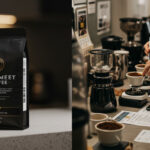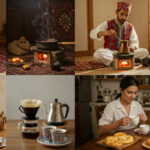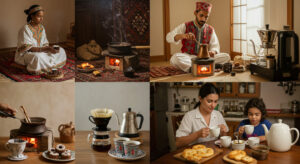
Definition and Classification of Gourmet Coffee: A Beginner’s Guide

Table of Contents
ToggleWhat is Gourmet Coffee?
Definition and Key Characteristics
Gourmet coffee is more than just a beverage; it’s an experience crafted with precision, passion, and premium ingredients. Unlike ordinary coffee, gourmet coffee is defined by its exceptional quality, unique flavors, and meticulous production process. It often originates from specialty Arabica beans, grown in ideal climates and harvested with care. These beans are typically roasted in small batches to highlight their distinctive aromas and tasting notes, ranging from fruity and floral to nutty and chocolatey. The result is a cup of coffee that is rich, complex, and deeply satisfying.
Key characteristics of gourmet coffee include:
- High-quality Arabica beans, often sourced from specific regions known for their coffee profiles.
- Careful processing methods, such as washed, natural, or honey processing, to enhance flavor.
- Small-batch roasting to preserve the beans’ unique qualities.
- A focus on freshness, ensuring the coffee is consumed at its peak flavor.
- Complex flavor profiles that reflect the beans’ origin and processing techniques.
Difference Between Gourmet and Regular Coffee
While both gourmet and regular coffee come from the same plant, their differences lie in quality, preparation, and experience. Regular coffee is often mass-produced, using a mix of Arabica and Robusta beans, which are less expensive but can result in a more bitter and less nuanced flavor. It is typically roasted in large quantities and may sit on shelves for extended periods, compromising freshness.
On the other hand, gourmet coffee is a celebration of craftsmanship. Here’s how it stands apart:
- Bean Quality: Gourmet coffee uses 100% Arabica beans or specialty-grade beans, chosen for their superior flavor and aroma.
- Roasting: Small-batch roasting allows for precise control over the roast profile, enhancing the beans’ natural characteristics.
- Freshness: Gourmet coffee is often roasted to order or shortly before sale, ensuring maximum freshness.
- Flavor: The emphasis is on complexity and balance, with tasting notes that tell the story of the beans’ origin.
In essence, gourmet coffee is for those who seek more than just caffeine—it’s for those who want to savor every sip and appreciate the artistry behind their cup.
The Origins of Gourmet Coffee
The Importance of Terroir and Growing Regions
At the heart of every cup of gourmet coffee lies its terroir—a French term that encapsulates the unique combination of soil, climate, and geography that shapes the flavor profile of coffee beans. Just as wine enthusiasts celebrate the influence of terroir, coffee lovers recognize how specific growing regions impart distinct characteristics to their brews. From the volcanic soils of Guatemala to the high-altitude estates of Ethiopia, each region contributes its own sensory signature to the beans.
- Africa: Known for bright acidity and fruity notes, Ethiopian and Kenyan coffees are celebrated for their complexity.
- Latin America: Colombian and Costa Rican beans often feature balanced acidity with nutty, chocolatey undertones.
- Asia-Pacific: Indonesian coffees, like Sumatran, are famous for their earthy, full-bodied profiles.
The Role of Altitude and Climate in Flavor Development
Altitude is a critical factor in crafting gourmet coffee. Beans grown at higher elevations, typically above 1,200 meters, develop more slowly, allowing sugars to concentrate and flavors to deepen. This results in a more nuanced and vibrant cup. Additionally, cooler temperatures at higher altitudes reduce the risk of pests, enabling farmers to focus on quality rather than quantity.
Climate also plays a pivotal role. Consistent rainfall, ample sunlight, and temperate weather create ideal conditions for coffee plants to thrive. For example, the tropical climates of Central America provide the perfect balance of rain and sunshine, fostering the growth of beans with bright acidity and floral notes. In contrast, the monsoonal weather of Southeast Asia contributes to the bold, spicy flavors found in coffees like Java and Sulawesi.
“Altitude isn’t just a number—it’s a promise of flavor, a testament to the care and precision that goes into every bean.”
Classification of Gourmet Coffee
Specialty Coffee Association (SCA) Standards
The Specialty Coffee Association (SCA) sets the global benchmark for quality in the world of gourmet coffee. To achieve the coveted “specialty” label, coffee must score 80 or above on the SCA’s 100-point scale. This rigorous evaluation process assesses factors like aroma, flavor, acidity, body, and aftertaste. Only the finest beans, meticulously sourced and expertly roasted, meet these exacting standards.
The SCA also emphasizes sustainable practices, encouraging farmers to cultivate coffee in ways that are environmentally friendly and socially responsible. By adhering to these guidelines, specialty coffee not only delights the palate but also supports ethical production.
Grading Systems for Coffee Beans
When it comes to grading coffee beans, the two main contenders are Arabica and Robusta. While both have their merits, they differ significantly in flavor profiles and quality.
- Arabica: Known for its smooth, nuanced flavors, Arabica accounts for about 60% of global coffee production. It thrives at higher altitudes and is often associated with gourmet coffee due to its complex taste, which can include notes of fruit, berries, and chocolate.
- Robusta: Robusta beans are hardier, packing a stronger, more bitter punch with higher caffeine content. They’re typically used in espresso blends for their boldness and crema-enhancing properties. While less refined than Arabica, high-quality Robusta can still be part of a gourmet experience.
Beyond species, coffee beans are graded based on size, shape, and defects. For example, Kenya uses a unique grading system like AA (larger beans) or AB (smaller beans), while Colombia grades beans by screen size. These classifications help ensure consistency and quality.
The Sensory Experience of High-Quality Coffee
Gourmet coffee isn’t just about taste—it’s a full sensory journey. From the moment you inhale the aromatic bouquet of freshly ground beans to the last lingering note of flavor, every sip tells a story. The SCA’s focus on sensory evaluation ensures that every aspect of the coffee—its aroma, acidity, body, and balance—is meticulously considered.
This attention to detail transforms coffee from a simple beverage into an artisanal experience, inviting you to explore the world’s diverse coffee-growing regions, each with its own unique characteristics.
The Sensory Experience of Gourmet Coffee
Aroma: The First Impression
When you take that first whiff of gourmet coffee, the aroma is your introduction to its character. High-quality gourmet coffee often boasts a complex and inviting scent, ranging from floral and fruity notes to hints of chocolate, nuts, or spices. The aroma is a direct result of the coffee’s origin, roast level, and freshness. To identify a truly exceptional cup, look for a rich, well-balanced aroma that feels layered and distinct, without any burnt or stale undertones.
Flavor: The Heart of Gourmet Coffee
The flavor profile of gourmet coffee is where the magic truly happens. Unlike ordinary coffee, gourmet varieties offer a symphony of tastes that can include anything from bright citrus and berry notes to deep, earthy tones like caramel or dark chocolate. The key to identifying high-quality gourmet coffee lies in its balance, clarity, and complexity. A great cup should have a clean finish, with no harsh or bitter aftertaste. Here are some common flavor characteristics to look for:
- Acidity: A bright, tangy quality that adds liveliness to the coffee.
- Sweetness: Natural sugars that create a smooth and pleasant taste.
- Bitterness: A subtle, well-rounded bitterness that enhances the overall flavor without overwhelming it.
Body: The Texture That Completes the Experience
The body of gourmet coffee refers to its texture and mouthfeel. Is it light and tea-like, or rich and creamy? High-quality gourmet coffee often has a full, satisfying body that feels luxurious on the palate. The body is influenced by factors like bean variety, roast level, and brewing method. For example, a French press might produce a heavier body, while a pour-over could yield a lighter, more delicate texture.
How to Identify High-Quality Gourmet Coffee
Recognizing top-tier gourmet coffee requires paying attention to several key indicators. Here’s a quick guide to help you spot the best:
- Freshness: Look for a roast date on the packaging. High-quality coffee is usually consumed within weeks of roasting.
- Origin: Single-origin coffees often showcase unique flavor profiles tied to their specific region.
- Breathing Time: Allow the coffee to rest after brewing. Aromas and flavors develop further as it cools.
- Consistency: Each sip should deliver a harmonious blend of aroma, flavor, and body.
Brewing the Perfect Cup of Gourmet Coffee
Recommended Brewing Methods
To truly savor the intricate flavors of gourmet coffee, choosing the right brewing method is essential. Each method extracts unique characteristics from the beans, enhancing your coffee experience:
- Pour-Over: This method allows for precise control over water temperature and brewing time, resulting in a clean, nuanced cup. It’s ideal for highlighting the subtle notes in specialty beans.
- French Press: Known for its full-bodied and rich texture, the French Press retains the coffee’s natural oils, offering a robust and aromatic brew.
- Espresso Machine: Perfect for those who enjoy concentrated flavors, espresso extracts the essence of gourmet coffee with a rich crema and intense aroma.
- AeroPress: A versatile and portable option, the AeroPress produces a smooth, sediment-free cup, making it a favorite among coffee enthusiasts on the go.
Experimenting with these methods can help you discover the perfect match for your palate.
Tips to Enhance Your Coffee Experience
Elevating your gourmet coffee experience goes beyond the brewing process. Here are some tips to help you make the most of every sip:
- Use Freshly Ground Beans: Grinding your coffee beans just before brewing preserves their flavor and aroma. Invest in a quality burr grinder for consistent results.
- Opt for Filtered Water: The quality of water significantly impacts the taste of your coffee. Using filtered water ensures a pure, unadulterated flavor.
- Mind the Ratios: A general rule of thumb is to use 1 to 2 tablespoons of coffee per 6 ounces of water. Adjust this ratio to suit your taste preferences.
- Pay Attention to Temperature: The ideal brewing temperature is between 195°F and 205°F. Too hot, and you risk bitterness; too cool, and the flavors may not fully develop.
- Store Coffee Properly: Keep your beans in an airtight container away from light, heat, and moisture to retain their freshness.
By incorporating these tips into your routine, you can unlock the full potential of your gourmet coffee, transforming it into a truly indulgent experience.
Why Choose Gourmet Coffee?
Health Benefits of Gourmet Coffee
Gourmet coffee is not just a treat for your taste buds; it also offers a range of health benefits. High-quality coffee beans are often richer in antioxidants, which help combat free radicals and reduce the risk of chronic diseases. Additionally, gourmet coffee is typically brewed with precision, ensuring that you get the optimal amount of caffeine without the bitterness or acidity found in lower-quality blends. This can lead to improved mental clarity, enhanced focus, and even a boost in mood.
Ethical Considerations
Choosing gourmet coffee often means supporting ethical and sustainable practices. Many gourmet coffee producers prioritize fair trade, ensuring that farmers are paid fairly for their labor. This not only improves the livelihoods of coffee-growing communities but also promotes environmentally friendly farming practices. By opting for gourmet coffee, you’re making a choice that aligns with your values—supporting both people and the planet.
Support for Sustainable Coffee Farming
Sustainable coffee farming is at the heart of many gourmet coffee brands. These farms focus on methods that preserve natural ecosystems and reduce environmental impact. For example:
- Shade-grown coffee protects biodiversity by allowing plants and animals to thrive.
- Organic farming avoids harmful pesticides and chemicals, keeping the soil and water clean.
- Water conservation techniques ensure that resources are used responsibly.
By choosing gourmet coffee, you’re not just enjoying a superior cup—you’re contributing to a movement that values quality, sustainability, and ethical responsibility.
How to Start Your Gourmet Coffee Journey
Where to Buy Gourmet Coffee
Embarking on your gourmet coffee journey begins with knowing where to source high-quality beans. While supermarkets may offer convenience, they often lack the freshness and variety found in specialty coffee shops and online retailers. Here are some trusted options:
- Local Specialty Coffee Shops: These shops often roast their beans on-site, ensuring peak freshness and flavor. Plus, their baristas can offer personalized recommendations.
- Online Retailers: Websites like Blue Bottle, Counter Culture, and Intelligentsia deliver freshly roasted beans straight to your doorstep. Look for transparency in sourcing and roast dates.
- Farmers’ Markets: Many small-batch roasters sell directly at local markets, providing a chance to connect with the people behind your coffee.
Recommendations for Beginners and Enthusiasts
Whether you’re a curious beginner or a seasoned enthusiast, starting with the right coffee can make all the difference. Here’s a guide to help you choose:
- For Beginners: Start with a medium roast from a well-known region like Colombia or Ethiopia. These coffees are approachable, with balanced flavors of chocolate, nuts, or fruit.
- For Enthusiasts: Explore single-origin coffees or micro-lots to experience the unique terroir of specific farms. Experiment with lighter roasts to uncover subtle floral or citrus notes.
- Brewing Tips: Invest in a quality grinder and use fresh, filtered water. Experiment with brewing methods like pour-over, French press, or AeroPress to discover your preferred style.
FAQs
What’s the difference between gourmet and regular coffee? Gourmet coffee focuses on high-quality beans, precise roasting, and meticulous brewing, resulting in a superior flavor profile compared to mass-produced coffee. How should I store my gourmet coffee? Store beans in an airtight container in a cool, dark place. Avoid refrigeration, as moisture can degrade flavor. Can I enjoy gourmet coffee without expensive equipment? Absolutely! While quality tools enhance the experience, even a simple French press or drip brewer can create a delicious cup if you start with great beans.
Your gourmet coffee journey is a personal adventure, rich with discovery and delight. Start small, stay curious, and savor every sip. The world of coffee is vast, and there’s always something new to explore.
is a writer and editor at Coffee With Finance, blending her love for coffee, personal finance, and visual storytelling. She crafts engaging articles, curates site images, and shares brewing tips, bean origins, and practical money advice. Anna believes that managing finances, like making great coffee, should be intentional and rewarding — bringing clarity, warmth, and beauty to every story she tells.




























Post Comment